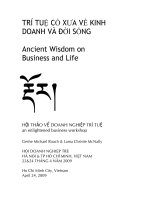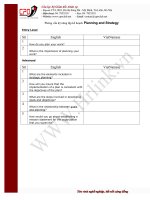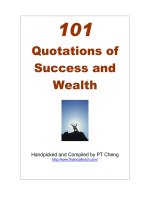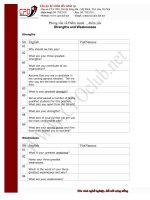Accenture Sales Transformation Sales Competency, Behavior and Personality doc
Bạn đang xem bản rút gọn của tài liệu. Xem và tải ngay bản đầy đủ của tài liệu tại đây (548.34 KB, 12 trang )
Accenture Sales Transformation
Sales Competency, Behavior
and Personality
An Integrated Approach to Improving
Sales Force Performance
Sales Transformation
Organizations of all kinds face numerous
performance challenges today: understand
and respond to changing customer needs,
support growth, improve profitability. Leading
organizations address these challenges by
transforming the performance of their sales teams
through a combination of art and science. In
mastering the “art” of sales—competency, behavior
and personality that define high performance—
“science” still plays a role, in the form of sales
analytics.
As companies refocus their attention on
growth, many find they are held back by
the very thing that should be propelling
them forward: their sales force. For too
many organizations, this critical function
is hampered by ineffective sales people
and with the expensive drag of turnover.
It’s a problem that has held the attention
of executives for many years—but one
that also has gone largely unsolved.
The challenge has been creating a model
that establishes what makes some
people better at sales than others—and
then supports the replication of those
characteristics across the entire
sales force. While many models have
been developed over the years, most
have focused on personality, skills or
behavior. The common shortcoming
of these models has been their failure
to integrate all three dimensions into
one holistic model. A model broad
enough to capture everything a good
sales person thinks and does, yet still
focused enough to apply to specific
business environments or even explain
the differences between sales roles.
Through a combination of research
and practical experience, Accenture
has developed such a model—what
we believe to be a novel approach to
integrating the sales competencies,
personality traits and behaviors of a
specific organization’s top performers
into a usable model that can improve
the effectiveness of every member
of the sales team. The foundation
of our approach is a proprietary
instrument that characterizes a
company’s highest sales performers,
assesses the entire sales force against
that “gold standard,” and enables the
company to close the gaps through
targeted improvement programs.
Introduction
Sales Competency, Behavior and Personality 3
4 An Integrated Approach to Improving Sales Force Performance
Increasing sales effectiveness is a top
concern for chief sales officers, especially
as organizations prepare for growth
in the post-recession world. However,
recent research shows that many
companies struggle to achieve this goal.
In 2009, research sponsored by Accenture
with the firm CSO Insights identified that
increasing sales force effectiveness was
the single most important objective for
chief sales officers, besting such goals as
increasing revenue, building market share
and improving margins.
1
Yet significant gaps exist between
sales leaders’ goals and their actual
achievements to date. For instance, only
six percent of these executives say their
companies’ ability to hire top-notch sales
people exceeded their own expectations.
In contrast, nearly 40 percent said this
capability needed improvement. What
does this suggest?
• One,manysalespeoplearen’tpulling
their weight: On average, the top 20
percent of the sales force generates
62 percent of a company’s revenue,
and 51 percent of sales people failed
to meet their quotas in 2009.
• Two,salesforceturnoveristoohigh,
with nearly one in four sales people
having left their employers last year
either voluntarily or involuntarily.
This level of attrition is enormously
expensive to companies: The total
cost of turnover averages between
three and four times the fully loaded
headcount cost, so the cost of turn-
over for a rep making $250,000 per
year is $750,000-$1,000,000. Making
matters worse is that, on average, it
takes more than eight months for that
person to become proficient—during
which time revenue from affected
accounts can dip to just 30 percent of
their overall potential, with associated
impacts to customer satisfaction and
loyalty.
Research also reveals that efforts
to improve sales force effectiveness
often fail. For instance, consider the
ongoing rise of variable pay: More
than 60 percent of Chief Sales Officers
The Sales Force
Performance Challenge
1. CSO Insights, “2009 Sales Performance Optimization Survey & Analysis,” March 2009.
Figure 1: Sales force effectiveness
Source: 2009 CSO Insights
10%
20%
70% of
Sales Force
The top 20% are bringing
in 62% of the revenue
80% of the sales force
only brings in 38% of
the revenue
Low
Performance
# of Sales Reps
Core High
formulated pay packages in 2009 in
which more than one-quarter of salary
was variable, a notable increase from
2008. However, further research shows
that the proportion of variable pay has
virtually no effect on the achievement of
sales quotas. In short, without knowing
which levers to pull to make their sales
forces more effective, today’s companies
are wasting time, effort and money—not
growing revenue.
While these findings underscore the
current level of urgency, boosting sales
effectiveness is not a new challenge. For
more than a century business people and
experts have tried to understand why
some people are more effective at sales.
Many models and approaches have been
proposed for raising the performance
of less effective sales people—from
frameworks that emphasize personality,
to others focusing on skills, to still others
identifying the specific behaviors that set
high performers apart. However, none
have substantially helped companies
replicate the critical characteristics of
top sales performers. We believe this is
because they have failed to integrate all
three legs of the sales force performance
stool: competencies, behaviors and
personality.
For example, methods that focus on
competency development often do not
address the key personality traits that
enable successful sales people. Likewise,
focusing on behavior fails to change the
underlying personality traits and skills
required to cement long-term behavior
change. And while personality is critical,
it is also a difficult trait to manage and
optimize in isolation from key skills and
behaviors.
Besides these limitations, many sales
performance models are hobbled by their
reliance on external benchmarks and
frameworks—i.e., the top skills required
for sales people in any given context—and
as such fail to deliver substantial
improvements within a specific
organization.
Sales Competency, Behavior and Personality 5
Recognizing the limitations of such
initiatives, the authors of this report be-
came interested in finding a better way
to address sales force performance. We
began by conducting a comprehensive
review of existing research on the topic.
This review resulted in an extensive list
of all the attributes that researchers
believed differentiated strong sales
performers from others.
Through our own primary research,
workshops with leading CSOs and
intensive analysis, we refined this list to
the more than 200 key competencies,
personality traits and behaviors that
truly explain, differentiate and predict
superior sales performance.
The resulting approach is similar to
others in that it is based on understand-
ing what distinguishes top sales people.
However, our approach differs from
other models in three critical ways.
• Itreliesonrigorousmeta-analysis
of more than a century of research
on this topic, extending the best
of these efforts with new primary
research.
• Itintegratesallthreeofthecritical
determinants of sales success into
one single model, tying together the
competencies, personality traits and
behaviors of top performers, and
using those insights as the basis for
improving sales force effectiveness.
• Ratherthanapplyingthesame
framework to all sales situations, the
Accenture approach is designed to
be tailored to specific situations and
specific roles—while still permitting
large-scale deployment—to accom-
modate company-specific drivers of
success.
A Different Approach
6 An Integrated Approach to Improving Sales Force Performance
For instance, not all organizations
define “high-performance sales
people” in the same way. Some may
base their definition on profitability
metrics, some on revenue, some
on customer satisfaction or HR
performance appraisals—and some
on a combination of these and other
key business measures. So, when
working with clients we first confirm
the principal metrics they use to define
high performance in sales, and then
gather and analyze several years of
sales performance data to determine
which specific sales people meet that
definition. In many cases, we may also
A core tenet of our approach is that
the drivers of high performance can
differ dramatically across sales roles,
companies, geographies and even across
business units or divisions of the same
company, and that these differences
must be considered when attempting
to improve sales performance. So,
instead of trying to boil down all of
our research and past researchers’ data
into one, all-inclusive, “one-size fits all”
model, we use it in combination with
company- and role-specific data to
understand what is needed to achieve
high performance within that specific
organization and within each of its sales
roles.
help companies redefine their definition
as part of transitioning to a new model.
Another example of the need for a
tailored approach: the substantial
yet subtle differences between two
different subsets of account managers
at one company we worked with. At
first glance, their similarities were
striking. Both groups were confident,
driven to achieve and committed to
self-improvement; dominant, responsible
and “masters of their own fate;” strong
at developing proposals and closing
business; and perceived by others to be
effective, strong leaders and likeable.
One Size Does
not Fit All
Sales Competency, Behavior and Personality 7
8 An Integrated Approach to Improving Sales Force Performance
Sales people who excel in cultivating
business from existing accounts.
Account Manager Group 1: Account Manager Group 2:
Sales people who excel at identifying
and converting new customers.
Politically savvy, social and empathetic. Socially savvy but not necessarily
sociable.
Strong in team orchestration.
Assertive and competitive, with a higher
propensity to control and command
interactions and events.
Adept at analysis and creativity Committed to techniques that had
worked well in the past.
However, the deeper analysis afforded
by our approach revealed that one group
was best described as sales people who
excelled in cultivating business from
existing accounts while the other was
better at identifying and converting
new customers. Moreover, the company
needed people playing both roles
to succeed. While the former group
members were politically savvy, sociable
and empathetic, the latter were socially
savvy but not necessarily sociable.
While those skilled in cultivating
business from existing accounts were
strong in team orchestration, the new-
account finders were better at being
assertive and competitive, with a higher
propensity to control and command
interactions and events. And while the
first groups were adept at analysis and
creativity, the second were committed
to techniques that had worked well in
the past (Fig 2).
Clearly, any attempt to develop these
two different groups using the same
approach would fall short. We found
that our approach to sales force
effectiveness enabled us to understand
both the similarities and the differences
among professionals in these roles,
and subsequently design recruiting,
training, coaching, management and
sales operations programs that would
optimize the performance of each.
The benefit of such an approach over the
“one-size-fits-all” is far greater accuracy
in understanding the combinations of
personality, competency and behavior
that correlate with and differentiate
high performance in sales—and an
improved ability to hire, promote, and
develop sales people accordingly. The
end result: An organization’s sales
people reach their full potential more
rapidly, building on their strengths and
overcoming their weaknesses to drive
revenue growth for the company.
Accenture recently conducted an
exercise to prove the validity of this
approach. In analyzing data on more
than 6,000 sales people—covering 15
distinct sales roles—we found that there
were approximately eight personality
traits and eight competencies that
appeared to be common across all
people. (We found no behaviors that
were consistently common across the
database.)
However, despite having such a
large sample and so much data, we
subsequently found that these common
attributes were not all that predictive
of sales performance—predictability
was around 55 percent, about the same
as flipping a coin! On the other hand,
when we incorporated company- and
role-specific contexts into the analysis,
we could identify attributes with
as much as 92 percent predictive
probability—meaning 92 percent of the
time, we could be highly certain that
a person would be a high or a core
performer, based on the attributes he
or she possesses, when viewed within
the context of a specific company and
specific role.
Figure 2: Account manager analysis
Organizations can subsequently use
these insights to design and implement
a range of workforce improvement
initiatives across the sales organization.
For instance, the tool provides hiring
managers with personality/competency
maps—informed by 46 different
personality attributes and 72 sales
competencies that predict success—that
can be used to help screen and select
new hires. After making a first pass
focused on sales personality, we
can then build the top ten to fifteen
predictive skills into subsequent
behavioral interviews.
By evaluating prospective hires
against those personality traits
during the interview process, a
recruiter can quickly know to what
degree that individual matches the
high-performance model by role and,
thus, has a high degree of potential
to be successful in the company,
or for another role that the person
might better match than was initially
being considered. Such maps, in our
experience, are highly predictive:
Managers who use them enjoy much
greater certainty that their new hires
will be high performers.
Companies also can draw on the
insights the tool provides to build
training curricula and coaching
programs that address the most
significant effectiveness gaps between
high performers and the rest of the
sales force. One company, for instance,
was able to use the tool to identify and
replicate the coaching capabilities of its
best sales managers. Sales people who
received regular coaching from these
leading managers achieved average
revenue increases of 17 percent—a level
of performance the tool helped spread
The heart of our approach is a
proprietary asset that enables us to
measure the competencies, behaviors
and personality traits of a company’s
highest sales performers, and then
assess the entire sales force against
those standards to identify the gaps
between the two groups. These insights
then enable the company to design,
prioritize, and implement targeted
improvement programs to close the
gaps.
The asset is highly scalable and easy
to deploy across an organization,
regardless of the number of sales
people involved or where they work or
reside. It features an intuitive Web-
based interface, linked to a proprietary
database, which gathers 360 degree
input—as well as self-evaluations—on
sales peoples’ competencies, behaviors
and personality traits.
This level of analysis and reporting
enables executives, managers and
individual sales people to gain
important and actionable insights into
sales performance. For instance, top
sales executives can run gap analyses
on the function’s effectiveness focused
on any role, product suite, business
unit or geography. A company’s sales
managers have access to detailed
information on the competencies and
behaviors of their teams and individual
team members and how they compare
with the high performers identified
using the company’s metrics and
definition. Individual sales people
benefit as well, with access to a detailed
depiction of their own personality
traits, competencies and behavior (in
relation to their role) and how they
compare with high performers on those
characteristics.
across the sales force. Insights like
these are especially valuable given the
typical variance we encounter between
what companies think are critical sales
force attributes and those that actually
correlate with high performance. In
fact, in our experience, as much as 50
percent of corporate training budgets
can be expended on programs that have
very little impact on sales performance.
Individuals themselves can gain
valuable insights into how they stack
up against high performers and begin
to make relevant changes on their own
as prescribed by a recommendation
engine Accenture has developed. For
example, if a person discovers he has
a strong, dominating personality but
high performers in his role tend to
be lower-key and more consultative,
the recommendation engine provides
steps the person can take to bring his
personality more in line with those of
top performers. The same comparisons
and relevant recommendations are
given for competencies and behaviors as
well, so each sales person has firsthand
knowledge of steps he or she can take to
become more effective.
In addition to addressing current gaps,
companies also can tap into Accenture’s
extensive database of best sales
practices to identify new personality
traits, competencies and behaviors
their sales force will need to shift to
new business or sales strategies—for
example, to move from tactical sales
to a solutions approach or to enter a
new product or geographic market. In
doing so, the company also can identify
which of its sales people would be most
successful in that new model (some
of whom, in fact, may not be high
performers in the existing model).
Analytics-Based Insight
into Sales Performance
Sales Competency, Behavior and Personality 9
When working with an organization
on a sales workforce improvement
initiative, we typically follow a four-
phase process. The first phase involves
planning and enablement: We work
with the company to assess its current
state and sales activities, and define
appropriate tiers of sales performance.
We also build a plan to communicate
with sales people regarding the goals
of the initiative and how it can benefit
them, and create a Web-based portal
that will collect—and ultimately give
sales people access to—appropriate sales
performance and development insights.
In the second phase, we roll out
our analytics tool across all target
sales roles and collect and analyze
financial and HR data, working
closely with sales leadership to ensure
that this data accurately reflects
the company’s current state and/
or desired future state. At the end
of this phase, the company will have
the performance of its sales force
accurately mapped, and will have
customized dashboards in place for
sales people, managers and executives
to access performance insights.
After these performance maps have
been created, Accenture analyzes them
to determine which personality traits,
competencies and activities drive
and predict sales success within that
company for each of its individual sales
roles. We then generate comprehensive,
personalized reports for each sales
person, manager and executive, which
highlight key gaps between them and
high performers, as well as pinpoint
coaching and development programs
that can help close those gaps. We also
create an easy-to-use portal with which
sales executives can generate their own
customized reports—for example, to
see the sales performance differences
between geographies, markets and roles.
The fourth and final phase translates
these gaps and programs into actionable
recommendations and a detailed
road map for the implementation of
targeted improvement programs across
the organization. While the specific
activities of this final phase vary by
company, they always include detailed
development plans with robust business
cases; coaching guides for managers
to use with their direct reports and
teams; and an online portal to support
ongoing coaching and development,
pre-hire and succession management,
and the continual refinement of
sales-related HR processes.
Following this approach, Accenture
helped one company identify ways to
generate a substantial improvement in
sales performance. The company, with
approximately $60 billion in revenue,
has 12,000 sales representatives, 1,500
sales managers, and an average sales
quota per representative of $5 million.
We were able to identify a number
of initiatives the company could take
to generate substantial operational
and financial benefits, including:
• Reducingannualinvoluntaryattrition
by 30 percent (from 10 percent to
7 percent), resulting in an annual
savings of $80 million by year five.
• Increasing,byyearfive,theratioof
high performers in the company’s
sales force from 10 percent to 12
percent and core performers from 65
percent to 70 percent—while reducing
the ratio of low performers from 25
percent to 18 percent.
• Increasing,byyearfive,salesquota
attainment among high performers
from 110 percent to 120 percent; core
performers from 80 percent to 90
percent; and low performers from 50
percent to 65 percent.
Overall, Accenture’s approach to
improving the company’s sales force
performance has an anticipated
net present value of $1.2 billion,
$840 million in margin uplift,
and is expected to generate a
revenue increase of approximately
$3.2 billion within five years.
A Four-Phase Process
10 An Integrated Approach to Improving Sales Force Performance
As recent research shows, companies
overall continue to struggle to
determine which levers to pull to
improve the performance of their sales
forces. Many companies struggle with
hiring the right sales people, have a
large percentage of sales people who do
not make their quota, and experience
significant attrition of sales people
each year. Such performance, if it
continues, will be a significant obstacle
for companies that are looking to take
advantage of growth opportunities
as the economy begins to improve.
With our unique approach to sales
force effectiveness, Accenture can
help companies overcome these
obstacles. We work with companies
to deeply understand the precise
combination of personality traits,
competencies and behaviors their
best sales people embody. We then
translate those insights into targeted
recruiting, coaching and development
programs, sales force optimization
initiatives and enterprise plans to infuse
those characteristics across a greater
percentage of their sales force. In
doing so, we can enable a company
to improve customer acquisition and
retention, grow revenue and reduce
the costs incurred by sales force
attrition and money spent on activities
that do not drive the top line.
About the Authors
Samuel R. Tepper, Ph.D.
Sam is the global lead of the High
Performance Sales Force Analytics
offering at Accenture. He advises clients
on improving sales force effectiveness,
focusing on a number of levers, including
talent management and strategy.
He has played a lead role in helping
Accenture pioneer a novel approach to
helping companies create a larger pool
of high sales performers, by integrating
organizational design, behavioral
sciences and advanced analytics.
Rick Bakosh
Richard (Rick) Bakosh is the managing
director of the Sales Transformation
practice at Accenture, where he leads a
global team of experts in sales strategy,
sales enablement, talent management
and sales operations. For more than
two decades, he has helped Fortune
500 companies improve business
performance by increasing revenues
and improving sales productivity.
Conclusion
For more information,
please contact:
Sam Tepper
Accenture
Sales Transformation
Richard J. Bakosh
Accenture
Managing Director—
Global Sales Transformation
For more information
about Accenture,
please visit
www.accenture.com/crm
The views and opinions in this article
should not be viewed as professional
advice with respect to your business.
Accenture, its logo, and High
Performance Delivered are trademarks
of Accenture. The use herein of
trademarks that maybe owned by
others is not an assertion of ownership
of such trademarks by Accenture
nor intended to imply an association
between Accenture and the lawful
owners of such trademarks.
About Accenture
Accenture is a global management
consulting, technology services
and outsourcing company, with
more than 190,000 people serving
clients in more than 120 countries.
Combining unparalleled experience,
comprehensive capabilities across all
industries and business functions,
and extensive research on the
world’s most successful companies,
Accenture collaborates with clients to
help them become high-performance
businesses and governments. The
company generated net revenues of
US$21.58 billion for the fiscal year
ended Aug. 31, 2009. Its home page
is www.accenture.com.
Copyright © 2010 Accenture
All rights reserved.
Accenture, its logo, and
High Performance Delivered
are trademarks of Accenture.









